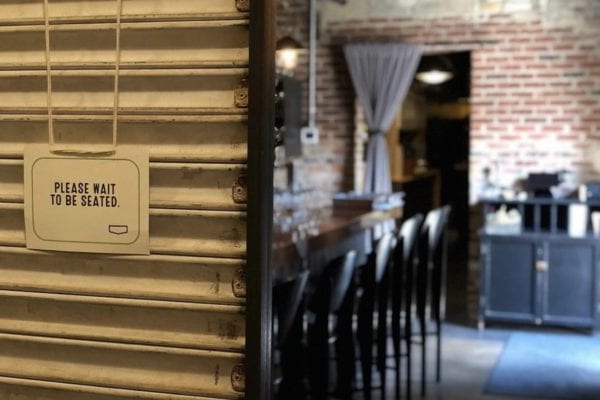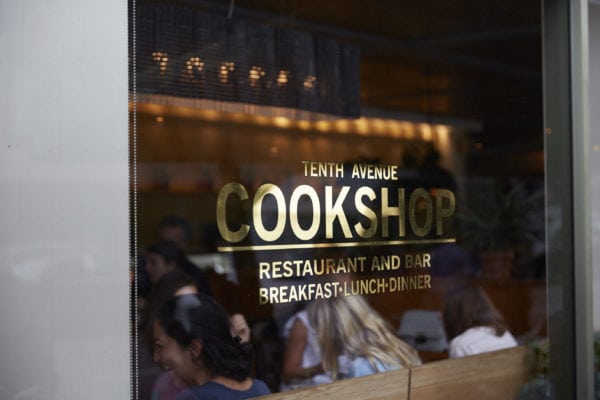Skift Take
Having a design team that really understands the business of restaurants, in addition to having a keen eye, is key to any successful partnership.
— Jason Clampet
 On Monday, September 24, Skift Table hosted its first ever Skift Restaurants Forum.
On Monday, September 24, Skift Table hosted its first ever Skift Restaurants Forum.
The day-long event featured interviews with restaurateurs, technology leaders, operators, and chefs, as well as an audience of over 300 people from across the restaurant industry.
In order to address the collaboration that takes place between designers and their restaurant clients, Oliver Haslegrave, the Founder and Director of Home Studios, sat down with collaborator Terry Coughlin, a Director of Operations at Union Square Hospitality Group (USHG). The two men worked together to create Caffe Marchiano and Vini e Fritti in midtown Manhattan. The two restaurants joined an existing third one, Marta, that USHG was already operating across the street to create a “piazza” of sorts, according to Coughlin.
Haslegrave and Coughlin were interviewed by Kristen Hawley, Senior Editor for Skift Table.
Read More Recaps and Interview Transcripts From Skift Restaurants Forum
Skift Table: Hello. Thank you very much for joining us.
Haslegrave: Thanks, we are happy to be here.
Skift Table: Everyone can appreciate a well designed restaurant, especially in operator when good design is also good for business. Oliver Hassle Grave is founder and creative director of Home Studios which works on hotel, restaurant, residential, and retail projects. And Terry Coughlin is a director of operations with Union Square Hospitality Group [USHG]. Specifically, we’re gonna talk about two restaurants, Caffe Marchio and Vini e Fritti today, both projects that Oliver and Terry have worked on together.
I’m going to start with you Oliver. I have a few general questions and then we’ll talk specifics. Generally, when you think about a well designed restaurant, what comes first? Is it ascetics or function of the space?
Haslegrave: I think you can’t kind of divide the two. We certainly start with function, but that is usually kind of evolving as the design evolves. So it’s really like a parallel path.
We’ve done somewhat over 40 projects at this point. My first few years when I moved here, I worked as a bartender and barback waiter. We really take function seriously, all the dimensions: Egress is very important.
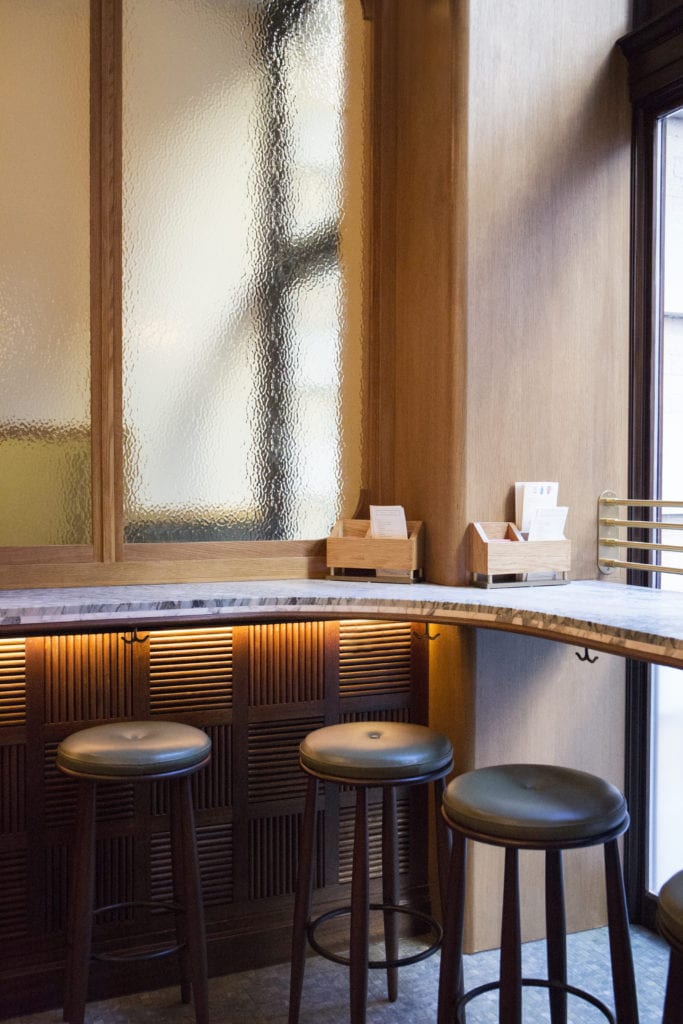
In general, we’re kind of trying to raise the temperature in the room, kind of create an alchemy or an energy and if the bartender has to take two extra steps every time they need to get a glass over the course of that night, that’s just that much less time that they have to talk to the people at the bar. Maybe the whole energy of the room, you know, dips a little bit.
The function is really important and the aesthetics I would say, you know, are equally important. But our role is kind of more of interpretation or translation, especially with restaurants.
The project that we worked on with USHG, it’s in a hotel, the hotel already has an aesthetic, they already had Marta, which is a restaurant that had been open for a number of years. That already had an aesthetic and then they had a kind of a vision for what they want these places to be, like holistically, and then individually. It’s kind of bringing all of that together and then interpreting it in a way that they feel really good about.
Skift Table: When you enter a restaurant that you haven’t worked on, what do you notice if it’s bad? What stands out?
Haslegrave: If there’s an informal hierarchy, its lighting is usually almost the first thing. Light levels, quality of light. LED [light-emitting diode] is slowly becoming the norm, energy codes making incandescent difficult to use even if you want to. Then distribution of light.
When I first moved here — this is like 2002 — one of the first things that I noticed was like the three tier, the pendant sconce and then table light, to kind of get that even glow. That’s not kind of a ubiquitous model, but usually you want people to look as good as possible.
And then, I don’t know if it’s because I’m getting older, but if a restaurant’s music is either too loud, too soft, or just doesn’t feel like it fits with the overall kind of feel of the room… Those are often things that hit you immediately. You haven’t sat down yet, you haven’t talked to the server or the bartender.
Skift Table: Technology seems to have changed restaurant operations across the board and I’m curious if the design has seen major changes [because of this]?
Haslegrave: It’s funny. In terms of the design process, the more technology the better — in terms of making how we make plans, how we make models, how we communicate intent to clients. But within the space, I think there’s going to be always this kind of deep undertow of wanting to be transported and wanting to escape the day to day.
I was just in Greece last week and I think a lot of the charm of the restaurants there, are the fact that it’s the complete opposite. Some of them are cooking everything without electricity, everything is handwritten. Others, a lot of natural light, sometimes you’re eating open air. A lot of that’s not so possible here or in most major cities. But I do think that our challenge a lot of the time is integrating the technology in a way that doesn’t make it feel front and center.
Skift Table: We like to also keep it real. I’m curious how far over budget your clients tend to go?
Haslegrave: We say we go way over budget, [but] fortunately, it’s generally not the case. It’s a constant conversation, and I think a lot of what we bring to the table is the ability of creating an overall solution.
That’s what we’re brought on to do, to kind of push the envelope a little bit in terms of the design but also in terms of what’s possible. You always have to respect the budget and the proforma. But, if you read enough stories about how great restaurants were made, it wasn’t always by not taking risks and not kind of being a little adventurous.
I think our primary responsibility is to show a design that’s feasible and that’s possible, and we always asked for kind of budget upfront, so that we’re not creating something that’s three X what they had in mind and then we find that out too late.
Haslegrave: Right.
Skift Table: Let’s talk specifics. We’ll start with Caffe Marchio. Terry, can you just give us a quick overview of the business there and what your priorities are?
Coughlin: Yeah, so Caffe Marchio is very, very specifically inspired by Rome. We opened Maialino restaurant about nine years ago and that was our first interpretation of Rome in so much as a Roman Trattoria. Then when we opened Marta, four years ago, that was our Roman pizzeria. And so at the time we wanted to continue to explore what other avenues of Rome’s culinary culture did we want to explore.
Specifically, with Caffe Marchio, we really, really wanted to capture the essence of the Roman coffee bar experience. And beyond just coffee, pastries and then also sort of things that you would enjoy throughout the day — sandwiches, salads, amaro, stuff like that. It was very much rooted in the Roman experience, which in terms of coffee experience is very, very different from the traditional New York coffee shop.
Skift Table: I’d love to hear from both of you about some of the standout design features and how they work for the business. And if you have some photos you would show.
Haslegrave: Well coincidentally, this doesn’t always happen. But when we kind of were brought on and we started working on the project, I was going to Italy right at the beginning of the design phase anyway. I was able to go to Rome and Milan. A lot of the images in our mood board were photos that I’d taken kind of from walking around Rome.
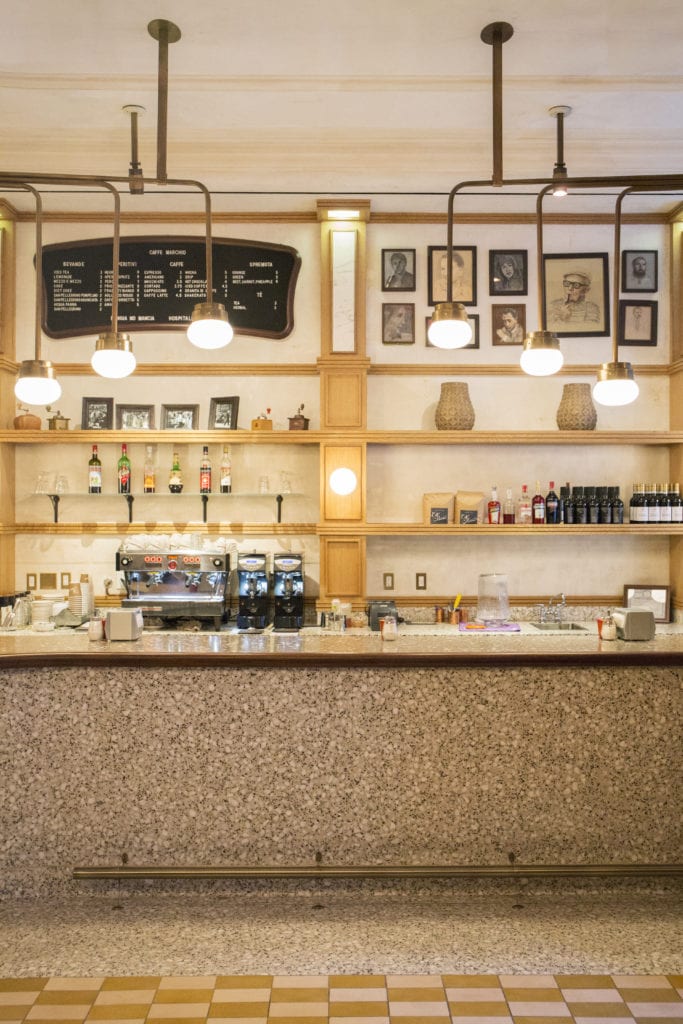
If there’s kind of a shorthand for our process, it’s a deep research, create a story, make it new. So the research was kind of that trip, and then as a team, the research we did in the studio. We had this story about a mom and dad who had created the coffee bar first and then had a daughter and then the two decades later she had created… and this is all kind of behind the scenes, nobody really knows this.
Internally, in terms of what the decor was and you know, how the two places would relate to each other. This was kind of an internal story that we had. So you can see it reflected in the art there. But a lot of what you see the terrazzo, that yellow and white tile, the stone work, the pebble glass in the windows. I mean, almost all of that is a direct interpretation of images that we saw when we were in Italy. And specifically Rome, too, not just other areas.
Coughlin: When we found out that Oliver was going to Rome two days out, or two weeks after, I think we signed you up for the project. It was such a win because we put together a list of probably way more places than you could even fit in. He’s running a marathon too, so…
I just remember the moment when you delivered the mood board, and I remember just going, “Wow, this is amazing.” And I sent it to Danny and he got back immediately and he had three words. “They get it.”
All the work that you put into the story and how personalized it, felt as music to [Danny’s] ears. I just remember him just saying back there, “This is it. They got it like they get Rome.”
Skift Table: Can you talk about how people move within [Caffe Marchio] because it is very different than a coffee place that you might see on the corner.
Coughlin: This is one of those examples of you first try for something and then sometimes you have to work with the designer to say, okay, let’s figure out a Plan B. If you notice in that one picture, you’ll see stools. We were so adamant about the idea that in, in Rome, you don’t have seats in a coffee bar. It’s very much a standup experience, and it’s a very quick experience.
Whereas, for meals like lunch particularly, and then dinner, it’s a very, very slow, drawn-out process in Rome. They really, really luxuriate over those experiences. Breakfast in Rome is a pastry and a quick coffee, but it’s part of that daily ritual. We really want to hang our hat on authenticity and unfortunately, one of the things that we had to sort of navigate through was, people came in and they would say, “Where’s my stool? Where do I sit and pull my laptop out and, order my coffee and camp out for the next two hours?”
And you get caught somewhere in between what you hope people were received, but then the reality of what they want it to be. And I think in the world of hospitality, it has to be a dialogue. It can’t just be a monologue. So guests say “We want to sit,” then we’re going to find that balance.
I remember, quickly going to Oliver and saying, “We need stools, really quick.” But we’re still trying to navigate that through, when you walk in now there is this beautiful terrazzo counter that we still try to put a firm line and say, “No stools here!” But then in other areas, we provide stools where you can sit and enjoy.
Skift Table: The one thing I would say you can’t see in the pictures that I noticed, is that the walls are very artfully distressed. It is quite authentic, I think that was a lovely touch.
Haslegrave: Yeah. It’s a challenge to kind of have Rome as your touchpoint and not have age be some critical part of the conversation. And you know, it’s an old beautiful building, the hotel, but this was a new build, internally. We did have to kind of, accelerate the process to a certain degree.
Skift Table: Cool. Yeah. I wanna move to another related project that you’ve worked together Vini e Fritti. Can you also give us an interview or an overview please of that Terry?
Coughlin: Sticking with the theme, this is something that when we first met with Oliver and the team we wanted to treat it like the hotel was a Roman piazza. And so you had your place to go get your pizza, you had your place to go get your coffee and your pastries. Vini e Fritta was your bar that you could get your glass of wine, or your a aperol spritz along with small, I think one of the things culinarily wise, Rome has these wonderful fried snacks, like fried artichokes and suplee and all kinds of stuff. So Vini e Fritti is a Roman version of a tapas bar.
Skift Table: And it’s table service, full service?
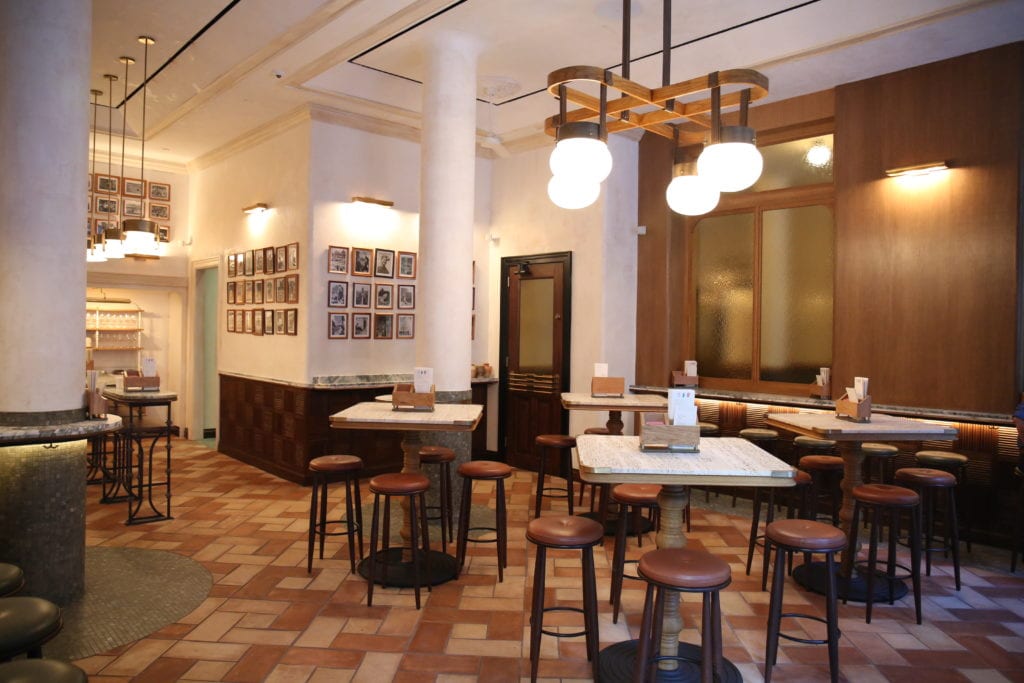
Coughlin: It is full service. It’s all bar height seating, there’s the bar proper and then there’s four, you can see in the picture, there four high-top tables. And then a lot of on the perimeter of the space also, high-top counter service. But yes, it’s full service.
Skift Table: Again, if you could talk through some standout design features here.
Haslegrave: Well, one great thing about this project was, we kind of come from a custom built background. I mean, the first half dozen projects we did, we actually built ourselves. We really think that custom work, in any incarnation, just kind of helps that accumulation of detail. Ultimately when it comes all together is what really makes this place stand out. So pretty much everything you see in these photos from the lighting, to the stools, the tables, the table base, the bar, all of the drawings on the wall, the door, hardware, windows, all of it’s custom.
I mean, I don’t think there’s much in here that isn’t custom actually. Which I think one help kind of distinguish it as, you know, you’re not going to walk into any other bar or restaurant and see that pendant. And it also helped, since we were kind of using Rome as our touchstone, and we’re in America.
It helped us bridge the gap between, you know, having an sourcing things largely in America currently that are trying to feel like they belong to Rome and do a Roman tradition that’s been there for a long time. I think in some ways that distinguishes it and it also helps it, you know, be a little more transportive, which is part of the goal.
Skift Table: Do you want to talk about how people kind of use this space, Terry, and how did your staff and, the general vibe?
Coughlin: I think they created a space that’s beautiful, but it doesn’t feel too fancy. And so I think most people just, they’ve really embraced it as just a fun place to gather to enjoy a glass of wine or enjoy a cocktail.
One thing that we’re really proud of is, it’s become a good industry space. So a lot of people that work in the restaurant industry really gravitate towards it. And that’s a big compliment, I think, to what we’ve created because I think there is a in so much experience of why people choose to be where they want to go drink.
It’s something that just makes them feel good. I love it because again, a lot of late nights people get off of work in the restaurant industry and gravitate towards there to go have a drink.
Skift Table: High praise. I do want to connect the dots between good functional design and, a bottom line of a restaurant. What you’ve mentioned, the bar and the way that a bar tender operates, can affect the way that they serve customers. What other small things do you notice that can actually, literally affect, make or break a business? In terms of design decisions that you make?
Haslegrave: I think seat count is one, multiply that by however many nights you’re open in a year and that could have a big impact. In terms of your guest experience, how many seats can we get in here? I think lighting, sound, like I said, one thing that you don’t notice a lot. But like HVAC, they have the exposed ducts here, so it’s back there, but you can see that little kind of like black outline in the ceiling. That’s our linear diffuser, for where all the HVAC is up above the ceiling so that there was no duct.
We generally try to do that, but it would have been a challenge to have a place that was coming from this old tradition and kind of having these, like that goes back. There’s not technology per say, but just mechanical. Really trying to kind of conceal as much as possible. That isn’t something that you want the guests to relate to emotionally.
Skift Table: Okay, great. I think we’ll probably have time for one audience question. I’m going to go with this one. How do you maximize seating without giving up on back of house so execution doesn’t suffer? So respecting the kitchen while also maximizing guest space.
Haslegrave: I think in general, and you’ll see this, we’re doing projects in like half a dozen other cities now and, New York definitely has the highest tolerance for having your neighbor literally next to you. People complain about it, but then when you take it away from them, they complain about that too.
I think the first complaint is the lesser one in that people generally are going out to meet people, to interact and that if somebody is too far away from you, you kind of don’t get that critical mass of energy or communal feeling.
I think that you have to address the kitchen first, you know, because if you’re undersized or if you can’t do what you’re promising, then it doesn’t matter how many seats you have. But we always try to at least create the first floor plan where it’s the maximum number of seats and then kind of mock it up and say, are you comfortable with this?
Skift Table: And you find your restaurant partners are on board with that?
Haslegrave: Sometimes. We did a project in L.A called Gwen, where it’s a much more upscale level of service and it’s a tasting menu and you need a certain size table just to fit everything that is being on offer. Sometimes the program will dictate that, you need a little more real estate for what they’re trying to do. But in general, yeah, that’s our kind of our goal.
Skift Table: Great. And that’s probably all the time that we have, but I want to thank you both very much for joining us.
Coughlin: Thank you.
Read More Recaps and Interview Transcripts From Skift Restaurants Forum


